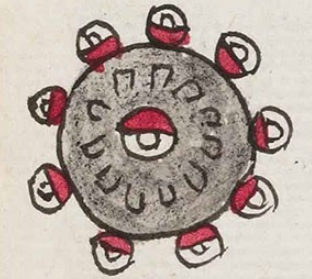Yohuallan (Mdz37r)
This simplex glyph for the place name Yohuallan doubles as the glyph for the night (yohualli). It is a circle with a dark gray interior and U shapes circling around a red and white eye in the center. Nine additional red and white eyes are evenly spread around the perimeter of the large circle. The eyes have a red eyelid covering half the small circle that comprises each one. In addition to the eyelid on each one is a white iris and a white pupil. The locative suffix (-tlan, or -lan after a stem ending in "l") meaning "place" is not shown in the typical way, with teeth (tlantli) providing the phonetic value, but perhaps the celestial landscape provides a semantic locative.
Stephanie Wood
These eyes are interpreted to be stars or starry eyes, presumably visible at night. In some yohualli glyphs, the field inside the main circle is purple. Sometimes, in addition to U shapes, this main field is dotted. These textures are reminiscent of those found on land parcels, such as the tlalli, the milli, the chinamitl, and the ixtlahuatl, raising the question of whether the sky was interpreted as a type of land up in the sky. If this is considered land, perhaps the locative suffix (-tlan or -lan, for place) is inherent in this.
Stephanie Wood
yoallan.puo
Yohuallan, pueblo
Stephanie Wood
c. 1541, but by 1553 at the latest
Stephanie Wood
sky, cielo, night, la noche, stars, estrellas, eyes, ojos, nombres de lugares

yohual(li), night, https://nahuatl.wired-humanities.org/content/yohualli
-tlan (locative suffix), place, https://nahuatl.wired-humanities.org/content/tlan
"In the Night" (Whittaker 2021, 29)
Codex Mendoza, folio 37 recto, https://digital.bodleian.ox.ac.uk/objects/2fea788e-2aa2-4f08-b6d9-648c00..., image 84 of 188.
Original manuscript is held by the Bodleian Libraries, University of Oxford, MS. Arch. Selden. A. 1; used here with the UK Creative Commons, “Attribution-NonCommercial-ShareAlike 3.0 License” (CC-BY-NC-SA 3.0)






